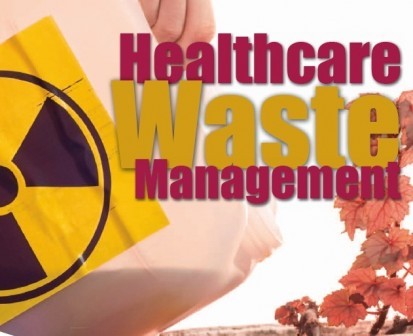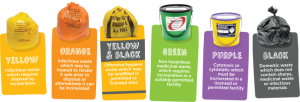
Table of Contents
Introduction: Health Care Waste Management (HCWM)
- Health care waste (HCW) refers to all waste generated in health care facilities such as hospitals, clinics, pharmaceutical manufacturing plants, research laboratories, nursing homes and other settings like homes where there is care for a patient
- Health-care waste includes all the wastes generated by medical activities.
- These are the waste produced while providing health care and services to the people.
- Majority of the health care waste i.e., 75% – 90% are non-risk or general waste. Remaining 10 – 25% of healthcare waste is regarded as hazardous and possess serious threat and health risk.
- Every year an estimated 16 billion injections are administered worldwide, but not all of the needles and syringes are properly disposed of afterwards.
- Approximately 5.2 million people globally die every year due to diseases caused by improper management of health care waste.
- Health care waste management (HCWM) is a process that ensures proper handling and disposal of the HCW in a safe way.
- HCWM includes all the steps necessary for waste management from planning to disposal.
Types of Health Care Waste:
1. General Medical Waste:
- General medical waste shares large portion in healthcare waste
- They are non-hazardous in nature.
- General waste includes paper, plastic, and office wastes.
- These can be disposed of regularly and don’t require any special handling.
2. Infectious Medical Waste:
- Infectious waste can pose several risks of infection to humans, animals, and overall environment.
- They contain pathogens.
- The waste includes blood-soaked bandages, sharps waste, surgical waste, human or body parts, cultures from laboratory and swabs.
- Infectious wastes are treated before disposal and they are to be handled with care.
3. Hazardous Medical Waste:
- Hazardous waste is dangerous waste
- Sharps fall into this category
- Sharps, needles, blades etc. can further puncture the handlers or users
- Chemicals, solvents, etc. also fall in this category
4. Radioactive Medical Waste:
- These wastes are radioactive in nature.
- Waste containing heavy metals, lead, battery, outcomes of radioactive therapies etc. fall in this category
- Pathological waste.
- Consists of tissues, organs, body parts, human fetuses and animal carcasses, blood, and body fluids. Within this category, recognizable human or animal body parts are also called anatomical waste.
- Radioactive medical waste is also considered as a subcategory of infectious waste
Methods of Health Care Waste Management:
1. Incineration:
- Incineration is the controlled method of burning the waste
- It is one of the oldest and most commonly used method of health care waste management.
- In this process, the organic waste is burnt in the high temperature producing mainly gaseous emissions, including steam, carbon dioxide, nitrogen oxides, and certain toxic substances.
- The gaseous emissions can be toxic as well.
- The incinerator varies from the pit burner to the very sophisticated high temperature running incinerator
- Incinerator when operated at optimum temperature kills the pathogen but if it is run at lower temperature, it causes more harm than benefit
- Pressurized gas containers, reactive chemical waste, radiographic wastes, waste with high mercury or cadmium content, etc. should never be incinerated
2. Chemical disinfection:
- Chemical disinfection is used to kill microorganisms on medical equipment, floors and walls
- It is also used to the treat the health-care waste.
- Chemicals are added to waste to kill or inactivate the pathogens
- This method is appropriate for treating liquid waste such as blood, urine, stools, or hospital sewage. However, other waste can also be disinfected using chemical disinfection, before disposal
- Anatomical parts, animal carcasses are usually not disinfected.
3. Autoclaving:
- Autoclaving is an efficient wet thermal disinfection process which is done using an autoclave
- Autoclaving is the processes of treatment in pressurized condition.
- Reusable medical equipment is sterilized by this process.
- An autoclave is used to sterilize reusable medical equipment like surgical equipment, laboratory instruments, pharmaceutical items, and other materials.
- This method can be used to sterilize solids, liquids, hollows, and instruments of various shapes and sizes.
4. Encapsulation:
- In this process, cubic boxes made of high-density polyethylene or metallic drums, are filled with are sharps and chemical or pharmaceutical wastes.
- These cubic boxes are not completely filled. The remaining portion is covered with mortar, dried and sealed before disposal.
- Encapsulation is very effective in reducing the risk of scavengers or stray animals gaining access to the hazardous health-care waste.
- Encapsulation is not suitable for non-sharp infectious waste, but may be used in combination with burning of such waste.
5. Inertization:
- Inertization is the process of mixing waste with cement and other substances before disposal.
- This reduces the chance of mixing of toxic substances contained in the waste to surface water or groundwater.
- Suitable for pharmaceuticals and for incineration ashes with a high metal.
- The typical proportions for the mixture is: 65% pharmaceutical waste, 15% lime, 15% cement and 5% water.
- Inertization however is expensive and not suitable for wider variety of waste
6. Land disposal:
- Land disposal is the way of disposal of waste rather than its treatment.
- There are two distinct types of waste disposal to land; open dumps and sanitary landfills.
- Open dumps are unmanaged and waste are scattered as well.
- The risk of the further transmission of the infection or disease is high.
- Sanitary landfills are scientific and designed for the disposal of hazardous waste.
- Sanitary landfill prevents contamination of soil and of surface water and groundwater.
- Sanitary landfill also checks the air pollution and contact with the public.
- Wastes are treated before disposal and managed on daily basis.
Risks Associated with Health Care Waste Management:
- Improper health care waste management has negative effects for a everyone.
- Those who collect and handle the waste are in more risk along with the general public.
- The medical staffs, nurses, the patient, and the children are in high risk.
- Waste handlers and the general public who are exposed to HCWM could be at risk of infection with hepatitis A, B and C as sharps and needles can puncture the handlers, if not handled carefully.
- Exposure to health care waste can cause diseases like diarrhea, leptospirosis, typhoid, cholera, and HIV, TB etc.
- Open burning and incineration of health care wastes can, under some circumstances, result in the emission of dioxins, furans, and particulate matter.
- Improper health care waste management pollutes the soil, surface and ground water as well.
- Some health care waste management techniques such as incinerator also causes air pollution.
References and for More Information:
http://www.who.int/news-room/fact-sheets/detail/health-care-waste
https://www.ncbi.nlm.nih.gov/pmc/articles/PMC5432984/
http://www.who.int/water_sanitation_health/medicalwaste/en/guidancemanual1.pdf
http://web.worldbank.org/archive/website01213/WEB/0__CO-74.HTM
https://www.redbags.com/types-of-medical-waste/
http://www.who.int/water_sanitation_health/medicalwaste/002to019.pdf
https://www.danielshealth.com/knowledge-center/improper-medical-waste-disposal
http://info.mcfenvironmental.com/blog/consequences-of-poorly-managed-waste-disposal
http://www.bwaste.com/key-methods-of-medical-waste-treatment-and-disposal/
https://noharm-global.org/issues/global/waste-treatment-and-disposal
https://www.hazardouswasteexperts.com/regulated-medical-waste-treatment-methods/
http://www.who.int/water_sanitation_health/medicalwaste/077to112.pdf
http://www.malsparo.com/treatment.htm
